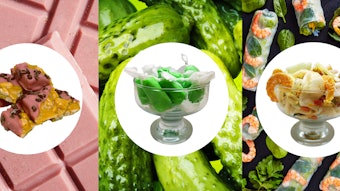A recent SFC meeting at The Monell Chemical Senses Center reveals that flavor is more than just one of life’s pleasures
The Monell Chemical Senses Center, established in 1968, is the world’s first and foremost scientific center for multidisciplinary research on the chemical senses of taste, smell and chemical irritation. Monell has more than 60 Ph.D. scientists working to increase fundamental knowledge of the chemical senses and improve public health and quality of life issues. The latest Society of Flavor Chemists meeting was the first held at the Center, allowing flavorists the chance to learn from the researchers and tour the facilities. While many flavorists’ day-to-day job focuses on delivering flavors per clients’ requests, this SFC excursion allowed everyone to learn more about the research behind how flavor is processed in the brain, how flavor preferences are formed, and even how flavor can affect health.
In the Beginning
The development of flavor preferences occurs very early in life; in fact, some preferences are formed while still in the womb. Catherine Forestell’s (Dalhousie University) research focuses on how experience affects the development of odor and flavor preferences in children. Forestell explained that a fetus’ taste buds are functional by the seventh week of gestation, allowing the fetus to perceive the odor of the food eaten by the mother, which is carried in the amniotic fluid. Once born, a child’s exposure to different tastes has significant impact on the acceptance of new foods later in life. For example, newborns that are pre-exposed to a range of flavors through breast milk (e.g., anise, garlic, carrot, mint, cheese, etc.) will be more likely to accept those flavors later in life. Forestell’s research shows that there is an increased acceptance of food over repeated exposure of that food. In addition, a child who is exposed to a variety of new food will be more likely to try new foods later in life.
Understanding Flavor
Paul Breslin (University of Pennsylvania) and Bruce Bryant (Boston University) both discussed how flavor is processed and sensed in the body. They explained that flavor = olfaction + taste + chemesthesis (sensations that arise when chemical compounds activate receptor mechanisms for other senses, usually those involved in pain, touch, and thermal perception). Breslin’s research focuses on understanding the integration of taste and smell using a tool called fMRI to comprehend regional brain activity. He explained that flavors that “go together” can be sensed by the brain even if the person is not consciously aware of it or if the flavors are at weak intensities. His research hypothesis is that taste and odor congruency can be conditioned.
Bryant’s research focuses on the fact that chemical irritants, both noxious (e.g., tear gas or hot pepper) and mild (e.g., menthol or carbonation), act on pain as well as thermal and tactile receptor. Using fluorescence imaging of intracellular calcium and nerve recordings, Bryant is able to characterize the transduction processes and coding mechanisms involved in chemical irritation. Knowledge of these mechanisms has applications ranging from foods and beverages to pharmaceuticals and personal care products to designing repellents for managing animal pests.
Flavor Affecting Health
Can flavor affect how our food is metabolized? Karen Teff’s (McGill University) research seeks to find out just that. Teff investigates the role of the parasympathetic nervous system in glucose homeostasis and cardiovascular function. In her presentation, “Cephalic Phase Hormonal Responses: The link between flavor and nutrient metabolism,” she explains that activation of the parasympathetic nervous system taste has the chance to influence how food is metabolized. Specifically, Teff wanted to find out if increasing the cephalic phase insulin amount would improve metabolism. She explained that the results in fact showed that a supplement of insulin in early phase (pre-digestion) improves metabolism in obese participants. In addition, she found that fat activates the parasympathetic nervous system more than low fat/carbohydrates alone.










